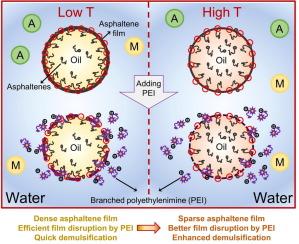Mechanistic insights into the role of branched polyethylenimine in breaking Asphaltene-Stabilized Oil-in-Water emulsions: Temperature effects
IF 8.1
1区 工程技术
Q1 ENGINEERING, CHEMICAL
引用次数: 0
Abstract
The stabilization of oil-in-water (O/W) emulsions by natural emulsifiers like asphaltenes poses significant economic and environmental challenges in oil production. Elevated temperatures in actual production strongly influence the demulsification processes. In this study, the performance of branched polyethylenimine (PEI), a reverse emulsion breaker (REB), in demulsifying asphaltenes-stabilized O/W emulsion was evaluated across different temperatures using bottle tests and detailed phase characterizations. Using techniques including dynamic interfacial tension (DIFT) measurements, atomic force microscopy (AFM) imaging, contact angle measurements, coalescence time measurements, and surface force measurements, the demulsification mechanisms of this PEI-type REB and the effect of temperature were comprehensively explored. The results indicate that PEI-type REB neutralizes the surface charges of oil droplets, induces reconfiguration and reorientation of asphaltenes, and disrupts the rigid interfacial films, reducing steric hindrance and electrical double layer (EDL) repulsion among oil droplets. Moreover, cationic REB molecules can bridge the negatively charged asphaltene films surrounding oil droplets. The combined effects of weakened interfacial films, reduced repulsions among oil droplets, and REB bridging promote droplet coalescence, thereby improving demulsification. While increasing temperature slightly reduces REB adsorption at the interfaces, it enhances demulsification by weakening the asphaltene films, lowering droplet surface charges, and reinforcing the bridging effect of REB molecules, collectively promoting droplet coalescence. This study offers critical insights into the interfacial interactions between asphaltenes and REB at different temperatures, advancing the understanding of O/W emulsion demulsification mechanisms and guiding the development of effective REBs for enhanced oil–water separation, particularly under high-temperature conditions in the petroleum industry.

求助全文
约1分钟内获得全文
求助全文
来源期刊

Separation and Purification Technology
工程技术-工程:化工
CiteScore
14.00
自引率
12.80%
发文量
2347
审稿时长
43 days
期刊介绍:
Separation and Purification Technology is a premier journal committed to sharing innovative methods for separation and purification in chemical and environmental engineering, encompassing both homogeneous solutions and heterogeneous mixtures. Our scope includes the separation and/or purification of liquids, vapors, and gases, as well as carbon capture and separation techniques. However, it's important to note that methods solely intended for analytical purposes are not within the scope of the journal. Additionally, disciplines such as soil science, polymer science, and metallurgy fall outside the purview of Separation and Purification Technology. Join us in advancing the field of separation and purification methods for sustainable solutions in chemical and environmental engineering.
 求助内容:
求助内容: 应助结果提醒方式:
应助结果提醒方式:


